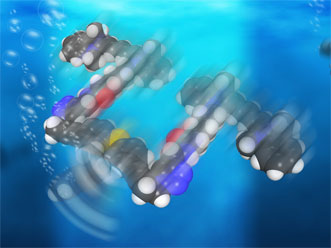Single-molecule machines that move through fluids with UV light-powered motors could someday carry cargo for medical and other applications.
Microscopic machines with motors have been developed over the years, said Rice University professor James Tour, but most have either used or generated toxic chemicals. He said a motor that was conceived in the last decade by a group in the Netherlands proved suitable for Rice's submersibles, which were produced in a 20-step chemical synthesis.

Light-driven, single-molecule submersibles contain just 244 atoms. Courtesy of Loïc Samuel/Rice University.
The UV motors operate more like a bacteria's flagellum than a propeller. When excited by 365-nm light, the double bond that holds the motor to the sub body becomes a single bond, allowing it to rotate a quarter step. As the motor seeks to return to a lower energy state, it jumps adjacent atoms for another quarter turn. The process repeats as long as the light is on.
With each full revolution, the tail-like propeller moves the nanosub forward 18 nm. The motors run at a rate of more than 1 million rpm, translating to top speeds of <1 in./s — a breakneck pace on the molecular scale, according to the researchers.
"These are the fastest-moving molecules ever seen in solution," Tour said.
While they can't be steered yet, the study proves molecular motors are powerful enough to drive the nanosubs through solutions of moving, similarly sized molecules.
For comparison tests, the lab also made submersibles with no motors, slow motors and motors that paddled back and forth. All versions of the submersibles had pontoons that fluoresced red when excited by a laser to enable tracking of the molecule.
Once built, the Rice team submitted the nanosubs to researchers at North Carolina State University, who measured their movement. The NC State team sandwiched a drop of diluted acetonitrile liquid containing a few nanosubs between two slides and used a custom confocal fluorescence microscope to hit it from opposite sides with both UV light to excite the motor and a red laser to excite the fluorophores in the pontoons.
The microscope's laser defined a column of light in the solution within which tracking occurred, guaranteeing the researchers were analyzing only one molecule at a time.
The research was published in Nano Letters (doi: 10.1021/acs.nanolett.5b03764).
